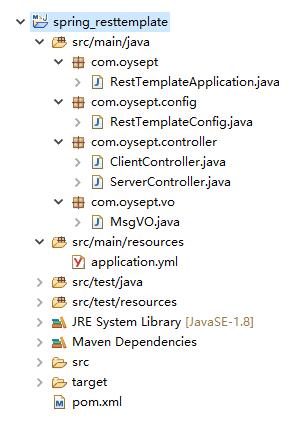SpringBoot RestTemplate GET POST請(qǐng)求的實(shí)例講解
一)RestTemplate簡(jiǎn)介
RestTemplate是HTTP客戶端庫(kù)提供了一個(gè)更高水平的API。主要用于Rest服務(wù)調(diào)用。
RestTemplate方法:
方法組 描述getForObject
通過(guò)GET檢索表示形式。
getForEntity
ResponseEntity通過(guò)使用GET 檢索(即狀態(tài),標(biāo)頭和正文)。
headForHeaders
通過(guò)使用HEAD檢索資源的所有標(biāo)頭。
postForLocation
通過(guò)使用POST創(chuàng)建新資源,并Location從響應(yīng)中返回標(biāo)頭。
postForObject
通過(guò)使用POST創(chuàng)建新資源,并從響應(yīng)中返回表示形式。
postForEntity
通過(guò)使用POST創(chuàng)建新資源,并從響應(yīng)中返回表示形式。
put
通過(guò)使用PUT創(chuàng)建或更新資源。
patchForObject
通過(guò)使用PATCH更新資源,并從響應(yīng)中返回表示形式。請(qǐng)注意,JDK HttpURLConnection不支持PATCH,但是Apache HttpComponents和其他支持。
delete
使用DELETE刪除指定URI處的資源。
optionsForAllow
通過(guò)使用ALLOW檢索資源的允許的HTTP方法。
exchange
前述方法的通用性強(qiáng)(且意見(jiàn)少的版本),在需要時(shí)提供了額外的靈活性。它接受RequestEntity(包括HTTP方法,URL,標(biāo)頭和正文作為輸入)并返回ResponseEntity。
這些方法允許使用ParameterizedTypeReference而不是Class使用泛型來(lái)指定響應(yīng)類型。
execute
執(zhí)行請(qǐng)求的最通用方法,完全控制通過(guò)回調(diào)接口進(jìn)行的請(qǐng)求準(zhǔn)備和響應(yīng)提取。
二)RestTemplate案例
第一步:創(chuàng)建一個(gè)maven項(xiàng)目,在pom.xml引入一個(gè)springboot的版本
pom.xml內(nèi)容:
<project xmlns='http://maven.apache.org/POM/4.0.0' xmlns:xsi='http://www.w3.org/2001/XMLSchema-instance' xsi:schemaLocation='http://maven.apache.org/POM/4.0.0 http://maven.apache.org/xsd/maven-4.0.0.xsd'> <modelVersion>4.0.0</modelVersion> <groupId>com.oysept</groupId> <artifactId>spring_resttemplate</artifactId> <version>0.0.1-SNAPSHOT</version> <packaging>jar</packaging> <parent> <groupId>org.springframework.boot</groupId> <artifactId>spring-boot-starter-parent</artifactId> <version>2.1.4.RELEASE</version> <relativePath/> </parent> <dependencies> <dependency> <groupId>org.springframework.boot</groupId> <artifactId>spring-boot-starter-web</artifactId> </dependency> </dependencies> <build> <plugins> <plugin><groupId>org.springframework.boot</groupId><artifactId>spring-boot-maven-plugin</artifactId><configuration> <mainClass>com.oysept.RestTemplateApplication</mainClass></configuration> </plugin> <plugin><groupId>org.apache.tomcat.maven</groupId><artifactId>tomcat7-maven-plugin</artifactId> </plugin> </plugins> </build></project>
application.yml配置:該配置就一個(gè)默認(rèn)端口
server:
port: 8080
創(chuàng)建一個(gè)springboot啟動(dòng)類RestTemplateApplication
package com.oysept; import org.springframework.boot.autoconfigure.SpringBootApplication;import org.springframework.boot.builder.SpringApplicationBuilder; @SpringBootApplicationpublic class RestTemplateApplication { public static void main(String[] args) { new SpringApplicationBuilder(RestTemplateApplication.class).run(args); }}
到此步驟時(shí),可以先運(yùn)行RestTemplateApplication中的main方法,檢驗(yàn)springboot啟動(dòng)是否正常。
第二步:創(chuàng)建一個(gè)RestTemplate配置類并注入,因?yàn)樵谑褂脮r(shí),不提前注入ResttTemplate,在通過(guò)@Autowired使用會(huì)報(bào)RestTemplate找不到
package com.oysept.config; import org.springframework.context.annotation.Bean;import org.springframework.context.annotation.Configuration;import org.springframework.web.client.RestTemplate; /** * 注冊(cè)一個(gè)RestTemplate Bean, 否則直接通過(guò)@Autowired使用會(huì)報(bào)RestTemplate找不到 * @author ouyangjun */@Configurationpublic class RestTemplateConfig { /** * 方式一: 默認(rèn)是使用JDK原生java.net.HttpURLConnection請(qǐng)求 * @return */ @Bean(name = 'restTemplate') public RestTemplate restTemplate() { return new RestTemplate(); } /** * 方式二: 使用apache http內(nèi)置請(qǐng)求, 需要在pom.xml中引入相應(yīng)的apache jar * 可以使用HttpClient,設(shè)置一些http連接池等信息 * @return * @Bean(name = 'restTemplate') public RestTemplate restTemplate() { return new RestTemplate(new HttpComponentsClientHttpRequestFactory()); } */ /** * 方式三: 使用OkHttp內(nèi)置請(qǐng)求, 需要在pom.xml中引入相應(yīng)的OkHttp3 jar * 可以使用OkHttpClient,設(shè)置一些http連接池信息 * @return * @Bean(name = 'restTemplate') public RestTemplate restTemplate() { return new RestTemplate(new OkHttp3ClientHttpRequestFactory()); } */}
第三步:創(chuàng)建一個(gè)VO類,用于測(cè)試入?yún)⒑统鰠?/p>
package com.oysept.vo; public class MsgVO { private String msgKey; private String msgValue; public String getMsgKey() {return msgKey;} public void setMsgKey(String msgKey) {this.msgKey = msgKey;} public String getMsgValue() {return msgValue;} public void setMsgValue(String msgValue) {this.msgValue = msgValue;} public String toString() { return 'MsgVO [msgKey: '+this.msgKey+', msgValue: '+this.msgValue+']'; }}
第四步:創(chuàng)建一個(gè)服務(wù)端接口,用于測(cè)試
package com.oysept.controller; import java.util.ArrayList;import java.util.List; import org.springframework.http.MediaType;import org.springframework.web.bind.annotation.PathVariable;import org.springframework.web.bind.annotation.RequestBody;import org.springframework.web.bind.annotation.RequestMapping;import org.springframework.web.bind.annotation.RequestMethod;import org.springframework.web.bind.annotation.RequestParam;import org.springframework.web.bind.annotation.RestController; import com.oysept.vo.MsgVO; /** * 服務(wù)端, 提供接口被調(diào)用 * @author ouyangjun */@RestControllerpublic class ServerController { // 無(wú)參GET請(qǐng)求: http://localhost:8080/server/get @RequestMapping(value = '/server/get', method = RequestMethod.GET) public String get() { return '/server/get'; } // 帶參GET請(qǐng)求: http://localhost:8080/server/get/param?param=111222333444 @RequestMapping(value = '/server/get/param', method = RequestMethod.GET) public String getParam(@RequestParam(value = 'param') String param) { return '/server/get/param,' + param; } // 路徑中帶參GET請(qǐng)求: http://localhost:8080/server/get/url/AAAA/BBBB @RequestMapping(value = '/server/get/url/{one}/{two}', method = RequestMethod.GET) public String getUrl(@PathVariable('one') String one, @PathVariable('two') String two) { return '/get/url/{one}/{two},' + one + ',' + two; } // 無(wú)參GET請(qǐng)求, 返回List: http://localhost:8080/server/get/list @RequestMapping(value = '/server/get/list', method = RequestMethod.GET) public List<Object> getList() { List<Object> list = new ArrayList<Object>(); list.add(11); list.add('AA'); return list; } // 無(wú)參GET請(qǐng)求, 返回對(duì)象: http://localhost:8080/server/get/MsgVO @RequestMapping(value = '/server/get/MsgVO', method = RequestMethod.GET) public MsgVO getMsgVO() { MsgVO vo = new MsgVO(); vo.setMsgKey('keyAAA'); vo.setMsgValue('valueBBB'); return vo; } // POST請(qǐng)求, 表單參數(shù), application/x-www-form-urlencoded @RequestMapping(value = '/server/post/form', method = RequestMethod.POST, consumes = MediaType.APPLICATION_FORM_URLENCODED_VALUE) public MsgVO postForm(MsgVO msgVO) { System.out.println('msgKey: ' + msgVO.getMsgKey() + ', msgValue: ' + msgVO.getMsgValue()); return msgVO; } // POST請(qǐng)求, JSON參數(shù), application/json @RequestMapping(value = '/server/post/json', method = RequestMethod.POST, consumes = MediaType.APPLICATION_JSON_UTF8_VALUE, produces = MediaType.APPLICATION_JSON_UTF8_VALUE) public MsgVO postJson(@RequestBody MsgVO msgVO) { System.out.println('msgKey: ' + msgVO.getMsgKey() + ', msgValue: ' + msgVO.getMsgValue()); return msgVO; }}
第五步:創(chuàng)建一個(gè)測(cè)試服務(wù)端接口的API
import的類和注入的RestTemplate:
package com.oysept.controller; import java.net.URI;import java.util.HashMap;import java.util.List;import java.util.Map; import org.springframework.beans.factory.annotation.Autowired;import org.springframework.beans.factory.annotation.Qualifier;import org.springframework.http.HttpEntity;import org.springframework.http.HttpHeaders;import org.springframework.http.MediaType;import org.springframework.http.RequestEntity;import org.springframework.http.ResponseEntity;import org.springframework.util.LinkedMultiValueMap;import org.springframework.util.MultiValueMap;import org.springframework.web.bind.annotation.RequestMapping;import org.springframework.web.bind.annotation.RequestMethod;import org.springframework.web.bind.annotation.RestController;import org.springframework.web.client.RestTemplate;import org.springframework.web.util.UriComponentsBuilder; import com.oysept.vo.MsgVO; /** * 客戶端, 調(diào)用服務(wù)端提供的接口 * @author ouyangjun */@RestControllerpublic class ClientController { // 使用默認(rèn)請(qǐng)求方式 @Autowired @Qualifier(value = 'restTemplate') private RestTemplate restTemplate; // 在此處添加客戶端測(cè)試代碼}
1、GET請(qǐng)求
// 直接在瀏覽中輸入訪問(wèn)地址: http://localhost:8080/client/get@RequestMapping(value = '/client/get', method = RequestMethod.GET)public String get() { // 無(wú)參GET請(qǐng)求 String get = restTemplate.getForObject('http://localhost:8080/server/get', String.class); System.out.println('==>/server/get return: ' + get); // 帶參GET請(qǐng)求 String getParam = restTemplate.getForObject('http://localhost:8080/server/get/param?param=111222333444', String.class); System.out.println('==>/server/get/param return: ' + getParam); // 帶參GET url請(qǐng)求 String getUrlParam = restTemplate.getForObject('http://localhost:8080/server/get/url/{one}/{two}', String.class, 'AAAA', 'BBBB'); System.out.println('==>/server/get/url/{one}/{two} return: ' + getUrlParam); // 帶參GET url請(qǐng)求 Map<String, String> vars = new HashMap<String, String>(); vars.put('one', 'HHHH'); vars.put('two', 'EEEE'); String getUrlVars = restTemplate.getForObject('http://localhost:8080/server/get/url/{one}/{two}', String.class, vars); System.out.println('==>/server/get/url/{one}/{two} return: ' + getUrlVars); // 無(wú)參GET請(qǐng)求, 返回List @SuppressWarnings('unchecked') List<String> getList = restTemplate.getForObject('http://localhost:8080/server/get/list', List.class); System.out.println('==>/server/get/list return: ' + getList); // GET請(qǐng)求, 返回對(duì)象 ResponseEntity<MsgVO> entity = restTemplate.getForEntity('http://localhost:8080/server/get/MsgVO', MsgVO.class); System.out.println('==>/server/get/list return: ' + entity.getBody()); return 'GET SUCCESS';}
2、GET url中傳參請(qǐng)求
// 直接在瀏覽中輸入訪問(wèn)地址: http://localhost:8080/client/get/request// GET請(qǐng)求, url參數(shù), 在表頭中添加參數(shù)@RequestMapping(value = '/client/get/request', method = RequestMethod.GET)public String getRequest() { // url中參數(shù) Map<String, String> vars = new HashMap<String, String>(); vars.put('one', 'HHHH'); vars.put('two', 'EEEE'); // 請(qǐng)求地址 String uriTemplate = 'http://localhost:8080/server/get/url/{one}/{two}'; // 給URL地址encode轉(zhuǎn)碼 URI uri = UriComponentsBuilder.fromUriString(uriTemplate).buildAndExpand(vars).toUri(); // GET請(qǐng)求參數(shù) RequestEntity<Void> requestEntity = RequestEntity.get(uri).header('MyHeader', 'aaabbbcccddd').build(); // 響應(yīng) ResponseEntity<String> response = restTemplate.exchange(requestEntity, String.class); // 結(jié)果 System.out.println('==>/get/request header: ' + response.getHeaders().getFirst('MyHeader')); System.out.println('==>/get/request body: ' + response.getBody()); return 'POST SUCCESS';}
3、POST application/x-www-form-urlencoded表單傳參請(qǐng)求
// 直接在瀏覽中輸入訪問(wèn)地址: http://localhost:8080/client/postForm// POST請(qǐng)求, form表單入?yún)RequestMapping(value = '/client/postForm', method = RequestMethod.GET)public String postForm() { // uri String uriTemplate = 'http://localhost:8080/server/post/form'; // 設(shè)置請(qǐng)求頭為form形式: application/x-www-form-urlencoded HttpHeaders headers = new HttpHeaders(); headers.setContentType(MediaType.APPLICATION_FORM_URLENCODED); // 設(shè)置參數(shù), 和MsgVO中變量名對(duì)應(yīng) MultiValueMap<String, String> map = new LinkedMultiValueMap<String, String>(); map.add('msgKey', '1234'); map.add('msgValue', 'TestTest'); // 封裝請(qǐng)求參數(shù) HttpEntity<MultiValueMap<String, String>> requestb = new HttpEntity<MultiValueMap<String, String>>(map, headers); ResponseEntity<String> response = restTemplate.postForEntity(uriTemplate, requestb, String.class); System.out.println('==>/server/post/form return: ' + response.getBody()); return 'POST SUCCESS';}
4、POST application/json JSON傳參請(qǐng)求
// 直接在瀏覽中輸入訪問(wèn)地址: http://localhost:8080/client/postJson// POST請(qǐng)求, JSON入?yún)RequestMapping(value = '/client/postJson', method = RequestMethod.GET)public String postJson() { // json入?yún)? MsgVO vo = new MsgVO(); vo.setMsgKey('TTT'); vo.setMsgValue('KKK'); String uriTemplate = 'http://localhost:8080/server/post/json'; URI uri = UriComponentsBuilder.fromUriString(uriTemplate).buildAndExpand().toUri(); RequestEntity<MsgVO> requestEntity = RequestEntity.post(uri) .header('Content-Type', 'application/json; charset=UTF-8') .body(vo); ResponseEntity<MsgVO> response = restTemplate.exchange(requestEntity, MsgVO.class); System.out.println('==>/server/post/json return: ' + response.getBody()); return 'POST SUCCESS';}
項(xiàng)目結(jié)構(gòu)圖:

以上這篇SpringBoot RestTemplate GET POST請(qǐng)求的實(shí)例講解就是小編分享給大家的全部?jī)?nèi)容了,希望能給大家一個(gè)參考,也希望大家多多支持好吧啦網(wǎng)。
相關(guān)文章:
1. python爬蟲(chóng)實(shí)戰(zhàn)之制作屬于自己的一個(gè)IP代理模塊2. Ajax返回值類型與用法實(shí)例分析3. Vue element ui用戶展示頁(yè)面的實(shí)例4. HTML 絕對(duì)路徑與相對(duì)路徑概念詳細(xì)5. 如何在jsp界面中插入圖片6. 基于javaweb+jsp實(shí)現(xiàn)企業(yè)財(cái)務(wù)記賬管理系統(tǒng)7. 使用FormData進(jìn)行Ajax請(qǐng)求上傳文件的實(shí)例代碼8. css代碼優(yōu)化的12個(gè)技巧9. asp批量添加修改刪除操作示例代碼10. .NET6打包部署到Windows Service的全過(guò)程

 網(wǎng)公網(wǎng)安備
網(wǎng)公網(wǎng)安備